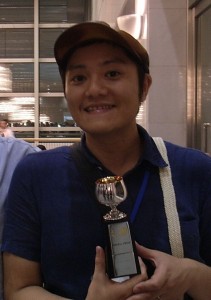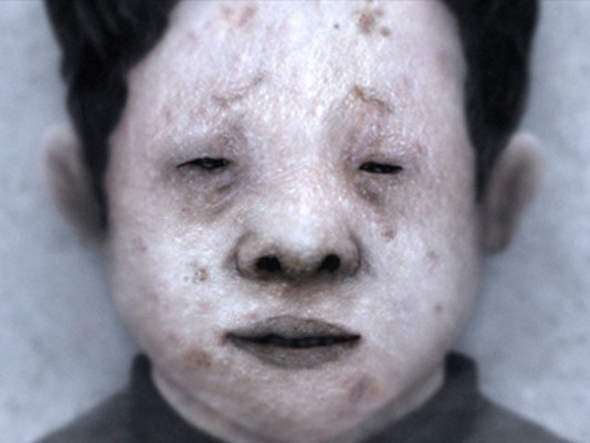 We recently had an opportunity to speak with Kei Oyama, a creator of animated films who was awarded a “Special Prize” at the Hiroshima International Animation Festival.
We recently had an opportunity to speak with Kei Oyama, a creator of animated films who was awarded a “Special Prize” at the Hiroshima International Animation Festival.
Kei Oyama: Graduate of the Image Forum Institute of the Moving Image. Graduate of Tokyo Zoukei University and a master’s program at that university’s graduate school. Member of the Japan Animation Association.
http://www.keioyama.com/
JAPIC (J): Congratulations on winning this Special Prize. You were the only Japanese person to win one of these awards [this year].
Kei Oyama (O): Thank you. I was excited just to have been selected for the competition so I am very happy to have won this prize.
J: You have been invited to many overseas film festivals this year, haven’t you?
O: I’ve been to [festivals in] Annecy, Zagreb, and Oberhausen, where I won a prize. I have also been invited to go to Ottawa. The Hiroshima festival is the largest animated film festival in Japan, and I was even more nervous than I usually am because so many people came to the screenings. At the same time I also had a feeling of satisfaction at finally having reached this point.
J: Is the atmosphere at overseas festivals different from at festivals in Japan?
O: Whether in Japan or overseas I think there are differences in the atmosphere at each individual festival. Annecy is very large, and it is impossible to distinguish between filmmakers, critics and regular audience members. Zagreb and Oberhausen are more relaxed and I was able to get to know other filmmakers and concentrate on appreciating the excellent selection of works that were screened. I was even approached by many audience members in the street. It was also interesting to me how audiences at different festivals reacted differently to the same film – the things they found funny, the timing of their laughter, the parts of the work they reacted to negatively, and so on. But I was really pleased when I was able to communicate a feeling directly using only images and sound without the intervention of language.

J: Did you have a chance to talk to other filmmakers in competition here in Hiroshima?
O: Yes. I’m not very good at English but I was able to talk with some of the other filmmakers. I was especially pleased when Estonian filmmaker Priit Pärn praised my work. I had been worried because HAND SOAP contains a lot of details that can only be properly understood by Japanese people, but I actually got the impression that he had a deeper understanding of the work than most Japanese viewers.
J: How was the reaction of Japanese viewers?
O: My work contains some disgusting scenes, so I don’t think it can be received favorably by most people, but there were some audience members who talked about it very passionately and even some who asked for my autograph…
J: Your autograph!?
O: Yes! Students, for example…
J: Students come from all over Japan to attend the Hiroshima International Animation Festival. You are no doubt one of the people they want to emulate.
O: After Koji Yamamura’s generation, it seems like the next generation [of animators] to emerge is people my age who are in or near their 30s. I recently formed a label called CALF with two people close to me in age, Atsushi Wada and Mirai Mizue, and just by chance all three of us have been able to take part in four major animation festivals this year: Annecy, Zagreb, Hiroshima and Ottawa. This sort of thing might never happen again, so we are planning to take advantage of this opportunity to do a good job of promoting CALF in Ottawa as well. I don’t know about being emulated, but I do feel that I have been getting a lot of attention.
J: You will be starting a one year artist in residence program in Vancouver next month. Could you tell us a bit about how this residence came about and what you plan to do while in Canada?
O: Short animated films are difficult to distribute as commercial products, and at this point it is difficult to say that they have established deep roots as [elements of] culture. At the same time, however, festivals for these works are held all over the world, and on a global scale the number of fans is not small. I have therefore thought for a long time that I must look to the world at large and become active internationally. I heard about the Agency for Cultural Affairs’ overseas residence program for emerging artists and decided to apply. As for what I plan to do during my residence, I will of course be absorbed in working on a film of my own, but as Canada is considered a leading country in the production of short animated films I also plan see many of the high-quality works being produced in Canada and get to know Canadian animators. I also hope to create opportunities to introduce Japanese filmmakers to people in Canada and conversely to introduce works I encounter in Canada after I return to Japan. Of course, I also hope to be able to successfully realize the work I will complete during my residence.
J: Thank you very much for speaking with us today.
Links:
Hiroshima Animation Festival
http://hiroanim.org/
Image Forum Institute of Moving Image
http://www.imageforum.co.jp/school/




